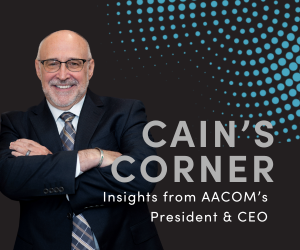Celebrating the Birth of Osteopathic Medicine: A Practice More Relevant than Ever
Published June 24, 2021
By Robert A. Cain, DO
2021 Cains Corner
Our nation is coming out of a crisis. People are just starting to reemerge and resume their normal lives. Many are shaken by the emotional, mental and physical toll they have gone through and are looking for ways to heal all aspects of themselves. While this all sounds familiar to us today, this was also the situation back in 1865 when Dr. Andrew T. Still was returning from his service in the Union Army after the Civil War. After witnessing firsthand the devastation and how the medical practices of his day were often more harmful than helpful, he devoted the rest of his life to exploring how treating the whole person—body, mind and spirit—could improve health and quality of life for his patients.
This week, we celebrate the 147th anniversary of Dr. Still introducing a new way of thinking about treating patients, a new philosophy of healing. He believed physicians should look beyond just prescribing the unreliable, and oftentimes unhealthy, drugs of the day. They needed to take a more holistic view of treating the whole patient. Fast forward to 2021, and that philosophy is resonating with people more than ever before.
The COVID-19 pandemic exposed the fragility of our nation’s healthcare safety net and for many people, it challenged and changed the way they approach their health. Going through prolonged periods of isolation, lockdowns and health scares, we realized just how interconnected our bodies, minds and spirits are and how they work together to lift us up or bring us down. Doctors of osteopathic medicine (DOs) are “physicians with a philosophy.” We focus on overall health and wellness, making sure we care for the whole person and not just treat disease.
In America today, DOs play a large and critical role in our nation’s healthcare system. More than 131,000 practicing DOs are treating patients across the healthcare spectrum. DOs serve as primary care practitioners, emergency room doctors, heart surgeons, pediatricians and throughout all medical specialty areas across towns large and small—even in the White House.
In 1892 Dr. Still opened the American School of Osteopathy and began teaching his philosophy and methods to a class of 21 men and women. Today, 25 percent of all medical students in the United States are trained in one of the 37 colleges of osteopathic medicine. Spread out across the country in 33 states and 58 teaching locations, these schools offer students the highest caliber education enhanced with training focused on osteopathic principles and osteopathic manipulative medicine.
Osteopathic medical education has never been more popular. Applications to osteopathic medical schools hit record levels this year, and this month, we saw the largest number of DO graduates in history. Our country has changed a lot since Dr. Still first went public with his ideas. But the founding principles that he first taught have remained the same and continue to attract the best and brightest minds who are called to care for and serve their communities. We can all be very proud of how osteopathic medical education has grown. I am confident Dr. Still would be.

Robert A. Cain, DO
AACOM President and CEO

